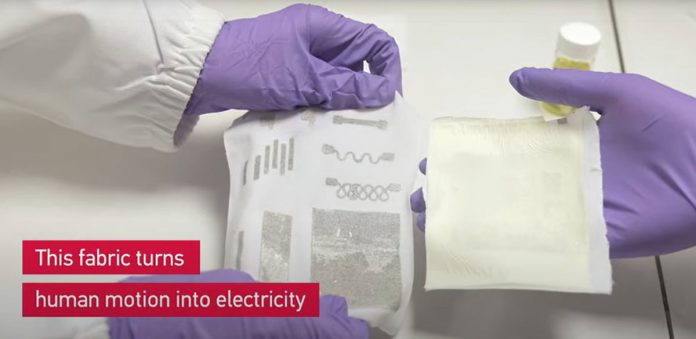NTU Singapore researchers have created a stretchable and waterproof “fabric” that converts energy generated by body movements into electrical energy. A polymer is a key component in the fabric because it turns mechanical stress into electrical energy when pressed or compressed. It’s also created with a base layer of elastic spandex and a rubber-like material to keep it sturdy, flexible, and waterproof.
The NTU Singapore team demonstrated that tapping on a 3cm by 4cm piece of the new fabric generated enough electrical energy to light up 100 LEDs in a proof-of-concept experiment published in the scientific journal Advanced Materials in April. The cloth did not degrade in performance whether washed, folded, or crumpled, and it could sustain a constant electrical output for up to five months.
Professor Lee Pooi See, a materials scientist and NTU Associate Provost (Graduate Education), who led the study, said: “Many attempts have been made to create fabric or garments that can harvest energy from movement, but one of the most difficult challenges has been to create something that does not degrade in function after being washed while maintaining excellent electrical output. In our research, we showed that our prototype still works after being washed and crumpled. We believe it might be weaved into t-shirts or built into the soles of shoes to capture energy from the body’s slightest movements and pipe it to mobile devices.”
Obtaining an alternative energy source
The NTU team’s electricity-generating fabric is an energy harvesting technology that converts vibrations produced by even the tiniest bodily movements into power. When the prototype fabric is crushed or squished (piezoelectricity), and when it comes into touch or is in friction with other materials, such as skin or rubber gloves, it produces electricity in two ways (triboelectric effect). To develop the prototype, the researchers first created a stretchable electrode by screen-printing silver and styrene-ethylene-butylene-styrene (SEBS), a rubber-like substance found in teethers and handlebar grips, to make it more flexible and waterproof. This stretchable electrode is then attached to a piece of nanofiber fabric made up of two main components: PVDFHPF (poly (vinylidene fluoride)-co-hexafluoropropylene), a polymer that generates an electrical charge when compressed, bent, or stretched; and lead-free perovskites, a promising material in the field of solar cells and LEDs.
Jiang Feng, a Ph.D. student at NTU and a member of the study team, explained: “The electrical output of the prototype is increased by embedding perovskites in PVDF-HPF. As a more environmentally benign choice, we used lead-free perovskites in our research. Perovskites are brittle by nature, but when incorporated into PVDF-HPF, they gain extraordinary mechanical durability and flexibility. The PVDF-HPF also adds to the mechanical properties and stability of the perovskites by acting as an extra layer of protection.”
The end result is a prototype fabric that generates 2.34 watts of electricity per square metre, enough to power small electrical devices like LEDs and commercial capacitors. a demonstration of the concept The NTU scientists demonstrated how a continuous hand tapping on a 3cm by 4cm patch of the prototype cloth could light up 100 LEDs or charge various capacitors, which are devices that store electrical energy and are found in gadgets such as mobile phones. The fabric’s electrical qualities did not deteriorate after washing, folding, or crumpling, indicating that it was durable and stable.
It also produced a consistent electrical output for the next five months. By attaching their fabric to the arm, leg, hand, and elbow, as well as the insoles 3 of shoes, the researchers demonstrated that it could harness energy from a variety of human movements while having no effect on the movements. “Despite greater battery capacity and lower power demand, power sources for wearable devices still necessitate regular battery replacements,” Prof Lee explained. Our findings reveal that our vibration-harvesting prototype fabric can potentially improve the life of a battery or even be used to create self-powered systems by harvesting vibration energy from a human. This is the first hybrid perovskite-based energy device that is stable, stretchy, breathable, waterproof, and capable of generating exceptional electrical output performance, to our knowledge.”
The NTU team’s body of work looks at how energy generated in the environment might be scavenged, and our fabric-based energy collecting prototype expands on that. For example, the team recently developed a form of film that could be put on roofs or walls to capture the energy generated by wind or rains falling on it. The researchers are currently investigating how the same cloth could be used to gather various types of energy.

